A Comparison of the Toyota VVT system Vs the Honda V-TEC
On this page I talk about the two different methods used to increase the power output, and what's good and bad about them.
What the two systems are, and why they are used
So lets have a look at each system, and how they work ...
Toyota Variable Valve Timing system, or VVT & VVT-i
(I can remember seeing a 1960's catalogue from the US that showed a special cam wheel that bolted onto a small block Ford engine's cam, and it had a mechanism that worked like a mechanical advance system in a distributor, so that as the revs picked up it advanced the cam timing. I also believe that Alfa Romeo or Fiat used a similar system back around then, or maybe before)
VVT is simple and fairly effective. It consists of only two main parts; an 'oil control solenoid' and the VVT mechanism itself.
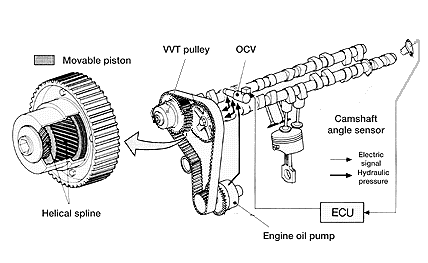
The early VVT system was relatively simple, ie, at a specific rpm (~4400rpm on the 20 valve 4AGE's) the computer signals the OCV to open, this lets oil pressure go through a special gallery in the #1 inlet cam bearing, through the centre of the inlet cam to the VVT pulley. There's a small piston in the VVT pulley, and once it gets enough pressure behind it, it starts to move outwards, causing the outer part of the pulley to turn in relation to the inner part, due to the helical spline that guides the piston's fore & aft movement.
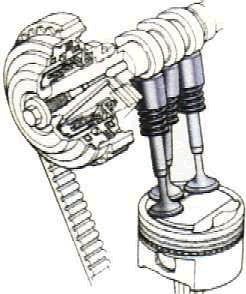
Closer view & cutaway of the VVT controller
So, when the computer signals for the VVT to operate, the OCV opens and thus causes the VVT pulley to advance the inlet cam timing by 30°, reference the crankshaft. (15° on the pulley itself)
The rpm at which this happens is worked out by running the engine on a dynamometer with the inlet cam in both the fully advanced and fully retarded positions. Since the two different cam timing's will make different power throughout the rev range, (advanced inlet give more top end power at the expense of low end power, and vice-versa) there is a point where the power will be identical for both cam settings, and this is where the VVT is programmed to operate. Because the power output is the same with the VVT in either position, you can't feel anything when it happens. You can, however, hear a change in engine note, just before there's a big increase in power!
More detail on the the VVT logic - The VVT comes in three types for the 20 valve. To the best of my knowledge, silvertop 20v's pre May 1993 have the VVT actuate at about 4400rpm. Post May 1993 they seem to work on throttle position and ignore revs.
The blacktops seem to work like this, as described on Club4AG -
1. Starting. When you crank the starter there will be VVT operation until the engine fires up, obviously to allow more air into the engine to allow an easier fire up.
2. Coolant temp. There is absolutely NO VVT operation when the coolant tempt is below 50°C except for that brief moment when you operate the starter. Reason obvious, who want to stress a cold engine.
3. Engine rpm. VVT will operate in any rpm between the range of 1500 and 7200 when the inlet manifold pressure is right. The min and max range can be a little out because I was reading from the car tacho. Trust me they are very close.
4. Engine load/inlet manifold pressure. This seems to be the single most important parameter controling the system. The VVT will NOT operate if the inlet manifold has more than about 5 inches of vacuum (can't get the exact reading because everything happen so fast. It's very close.). This is very close to zero vacuum which is atmospheric and that is about the maximum load the map sensor will read to tell the engine in an NA car. As you can figure out the throttle will usually be in the more than 3/4 position for this to happen.
5. VVT will work without the speed sensor.
Now, back to the above schematic of the VVT. It shows the second evolution of the VVT system - called VVT-i - where instead of the simple 'on' or 'off' positions of the earlier VVT system, this version can make the inlet cam retard/advance to any angle between the maximum limits, and to do this the camshaft has a position sensor on the back of the head. This means that the engine is even more flexible in it's power output than before. The latest version, VVTL-i is described on this page. It's completely different to the original VVT system, and is more like the V-TEC in operation.
There are two engines that commonly use the VVTL-i system, the 1ZZ-FE/2ZZ-GE series and the latest (in 1999 & onwards) 3SGE, as used in the sporty Altezza. The early generation 'redtop' four 3SGE's have a single inlet VVT-i and the later 'blacktop' generation four 3SGE's have dual VVT-i controllers, one on the inlet and the other on the exhaust cam, and makes 200hp from 2 litres.
So, using VVT technology, it's pretty easy to get around 100hp per litre.
Toyota has now gone to the third evolution of the VVT, and it not only alters the cam timing, but it also alters the valve lift as well. The 'old' VVT system simply can't do this, so Toyota has gone to a system much like the ....
HONDA V-TEC
The V-TEC system is far more complex than the VVT, but it allows you to not only alter the cam timing, but to alter the valve duration and lift at well. It's really like having two engines in one - A 'sedate' one for grocery-getting, and the other a red-blooded high revving screamer.
How it does this, however, is with a multitude of 'fiddly bits'. Here's a picture of the valve gear.
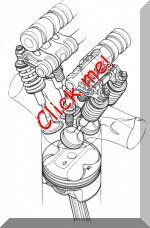 | (121kb pic <-- and --> 85kb pic) | 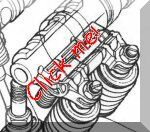 |
You can see from the above pictures, and the one below that there's been a huge amount of effort to make it all work. The cam followers all have small rollers, to reduce friction and allow for a larger cam lobe.
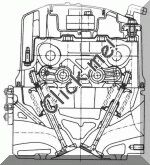
Here's a picture of a head that's been cross-sectioned. If you look very carefully at the right hand cam, you can just see the larger of the two sets of cam lobes hiding behind the smaller ones.
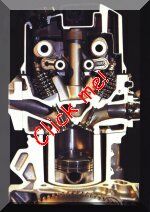
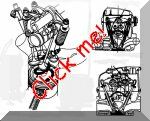
(84kb pic)
Below is the Nissan version of V-TEC, the VVL system. It's basically exactly the same as V-TEC in design and operation and so I assume is used under licence. This engine is the SR-16-VVL 'bluetop' and they make about 175hp from the factory. There's a similar N1 version that has a red coloured cam cover and they're reported to make 197hp. There's only suposed to be about 400 bluetops and 80 redtops made, and they were fitted to the faster versions of the Nissan Pulsars in Japan. This engine is my own, and it's going into my Mallock racing car. On the right is how it looked when I picked it up in Malaysia.
The VVT and V-TEC in operation in the real world
Pro's - Both systems allow you to have an engine that's quite a lot more powerful and yet still driveable than a 'conventional' engine would otherwise possibly be. The V-TEC is the obvious choice for outright power, and the Honda's certainly seem to rev a heck of a lot more than the Toyota's do. (The S2000 red lines at a stratospheric 9,000rpm - stock!)
Con's - You are pretty much stuck with limited modifications to the engine, eg, air filters, extractors, etc, to get more power. The reason for this is the very system that give the engine all that extra power - The cams & VVT/V-TEC. You can of course use larger cams to get more power, but this defeats the purpose of having the VVT/V-TEC in the first place. You'll most likely lose power at low revs, and not gain a great deal at high revs. (The VVT will gain proportionally more than the V-TEC, however, as the V-TEC head is optimised - well, compromised - for the 'big' cam & 'small' cam and so using a larger cam may not help much at all)
So, if you want an engine with power like a racing engine, then you're better off building a straight race engine right from the start. Or maybe a turbo engine ...
The other concern I have is the longevity of these sorts of engines. I believe that the VVT system would be largely trouble free for the life of the engine provided that you keep the oil clean and change it regularly. Even more so with the V-TEC, as with all it's little bits & pieces in close formation in the head I'd hate to think what would happen if some of those little locking pins didn't engage properly at 6000rpm+. All that being said though, I have it on reliable advice that Honda have never had a warrantee claim for any V-TEC engine in the area of the head and/or valve gear. Quite impressive.
I think that perhaps the best long term solution to getting large amounts of power from a relatively small engine is still by using a turbo, but if you like to hear the engine scream at high revs then one of these two systems is the way to go.


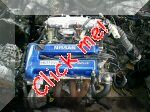
No comments:
Post a Comment